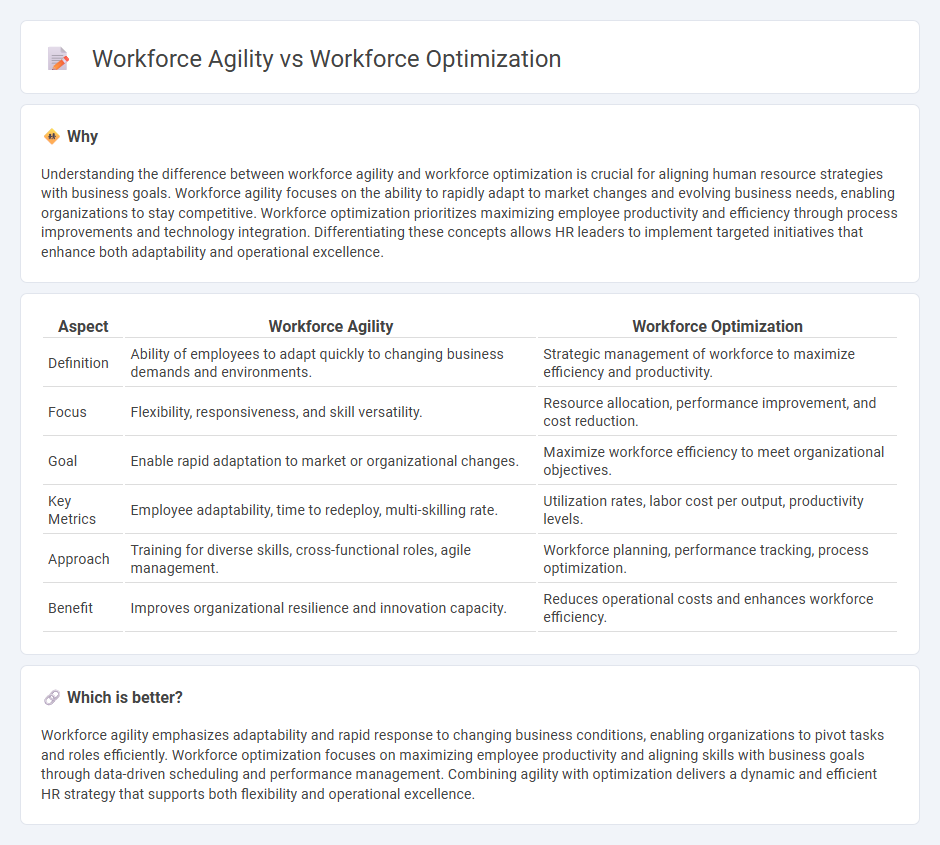
Workforce agility emphasizes the ability of employees to quickly adapt to changing business environments, enhancing responsiveness and innovation. Workforce optimization focuses on aligning workforce capacity with organizational goals to maximize productivity and efficiency through strategic resource management. Discover how balancing these approaches can drive your company's success in a dynamic market.
Why it is important
Understanding the difference between workforce agility and workforce optimization is crucial for aligning human resource strategies with business goals. Workforce agility focuses on the ability to rapidly adapt to market changes and evolving business needs, enabling organizations to stay competitive. Workforce optimization prioritizes maximizing employee productivity and efficiency through process improvements and technology integration. Differentiating these concepts allows HR leaders to implement targeted initiatives that enhance both adaptability and operational excellence.
Comparison Table
| Aspect | Workforce Agility | Workforce Optimization |
|---|---|---|
| Definition | Ability of employees to adapt quickly to changing business demands and environments. | Strategic management of workforce to maximize efficiency and productivity. |
| Focus | Flexibility, responsiveness, and skill versatility. | Resource allocation, performance improvement, and cost reduction. |
| Goal | Enable rapid adaptation to market or organizational changes. | Maximize workforce efficiency to meet organizational objectives. |
| Key Metrics | Employee adaptability, time to redeploy, multi-skilling rate. | Utilization rates, labor cost per output, productivity levels. |
| Approach | Training for diverse skills, cross-functional roles, agile management. | Workforce planning, performance tracking, process optimization. |
| Benefit | Improves organizational resilience and innovation capacity. | Reduces operational costs and enhances workforce efficiency. |
Which is better?
Workforce agility emphasizes adaptability and rapid response to changing business conditions, enabling organizations to pivot tasks and roles efficiently. Workforce optimization focuses on maximizing employee productivity and aligning skills with business goals through data-driven scheduling and performance management. Combining agility with optimization delivers a dynamic and efficient HR strategy that supports both flexibility and operational excellence.
Connection
Workforce agility enhances organizational responsiveness by enabling employees to adapt quickly to changing market demands, while workforce optimization focuses on aligning talent, skills, and resources efficiently to maximize productivity. Both concepts are interconnected as agile workforces leverage optimized processes and data-driven strategies to improve performance and drive business outcomes. This synergy ensures a dynamic, skilled, and efficiently managed workforce that can sustain competitive advantage in evolving industries.
Key Terms
**Workforce Optimization:**
Workforce optimization integrates data analytics, performance management, and scheduling tools to enhance employee productivity and operational efficiency. Key components include demand forecasting, real-time monitoring, and resource allocation to align workforce capacity with business needs. Explore how workforce optimization drives better decision-making and cost savings in dynamic environments.
Performance Management
Workforce optimization centers on maximizing employee efficiency and productivity through data-driven performance management, ensuring skill alignment and resource allocation meet organizational goals. Workforce agility emphasizes adaptability, enabling employees to quickly respond to changing market demands and business priorities by fostering continuous learning and flexible roles. Explore how integrating these approaches can enhance overall performance management strategies.
Resource Allocation
Workforce optimization emphasizes maximizing resource allocation by aligning employee skills and schedules with business demand to improve productivity and reduce costs. Workforce agility prioritizes flexible resource allocation, enabling quick adjustments to shifting market conditions and unexpected disruptions for sustained operational resilience. Explore deeper insights into how effective resource allocation strategies drive both optimization and agility in today's dynamic workplace.
Source and External Links
Workforce optimization: The ultimate guide for 2025 - Workforce optimization uses data and strategies to improve efficiency and performance by adopting a customer-first mindset, optimizing hiring and onboarding, and empowering employees with management software for better scheduling and coaching.
Your Workforce Optimization Guide For 2025 - Workforce optimization is a holistic approach to enhance business efficiency and employee productivity, focusing on a customer-first perspective and tools like attendance tracking to improve time management and reduce inefficiencies.
Workforce Optimization: The What, Why and How - Workforce optimization boosts employee efficiency, reduces turnover, increases productivity by matching staffing to demand, lowers operating costs, and improves customer satisfaction through better workforce management and automation.
 dowidth.com
dowidth.com